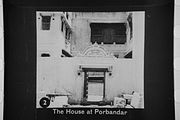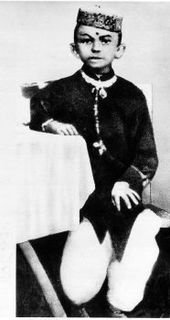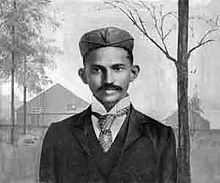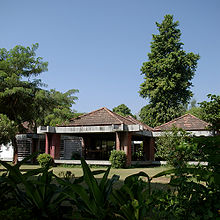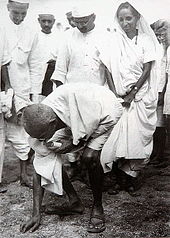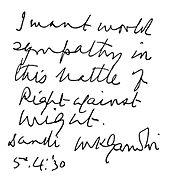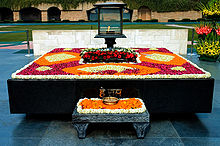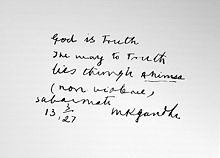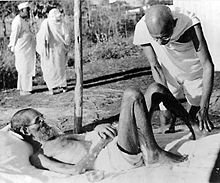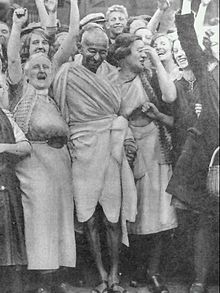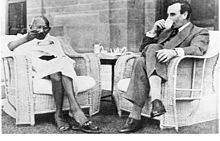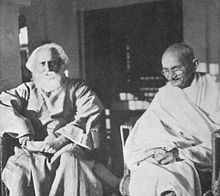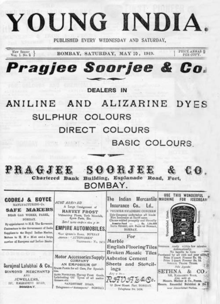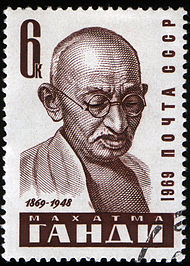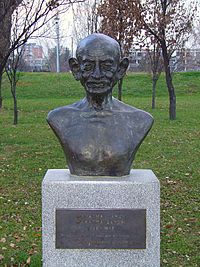- Mohandas Karamchand Gandhi
-
Mohandas Karamchand Gandhi 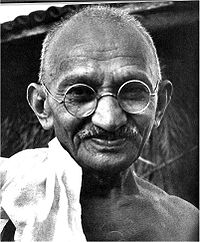
Born 2 October 1869
Porbandar, Kathiawar Agency, British IndiaDied 30 January 1948 (aged 78)
New Delhi, Union of IndiaCause of death Assassination by shooting Resting place Rajghat, New Delhi, India Nationality Indian Other names Mahatma Gandhi, Bapu Alma mater University College London,[1] University of London Known for Prominent figure of Indian independence movement
Propounding the philosophy of Satyagraha and Ahimsa
Advocating non-violence
PacifismReligion Hinduism Spouse Kasturba Gandhi Children Harilal
Manilal
Ramdas
Devdas
child who died in infancyParents Putlibai Gandhi (Mother)
Karamchand Gandhi (Father)Signature 
Mohandas Karamchand Gandhi (Gujarati: મોહનદાસ કરમચંદ ગાંધી; (Devnagari मोहनदास करमचंद गांधी), pronounced [moːɦənəd̪aːsə kərəmətɕənd̪ə ɡaːnd̪ʱi] (
 listen). 2 October 1869 – 30 January 1948) was the pre-eminent political and ideological leader of India during the Indian independence movement. A pioneer of satyagraha, or resistance to tyranny through mass civil disobedience—a philosophy firmly founded upon ahimsa, or total nonviolence—Gandhi led India to independence and inspired movements for civil rights and freedom across the world.[2] Gandhi is often referred to as Mahatma ([məɦaːt̪maː]; Sanskrit: महात्मा mahātmā or "Great Soul," an honorific first applied to him by Rabindranath Tagore).[3] In India, he is also called Bapu (Gujarati: બાપુ, bāpu or "Father") and officially honoured as the Father of the Nation. His birthday, 2 October, is commemorated in India as Gandhi Jayanti, a national holiday, and worldwide as the International Day of Non-Violence.
listen). 2 October 1869 – 30 January 1948) was the pre-eminent political and ideological leader of India during the Indian independence movement. A pioneer of satyagraha, or resistance to tyranny through mass civil disobedience—a philosophy firmly founded upon ahimsa, or total nonviolence—Gandhi led India to independence and inspired movements for civil rights and freedom across the world.[2] Gandhi is often referred to as Mahatma ([məɦaːt̪maː]; Sanskrit: महात्मा mahātmā or "Great Soul," an honorific first applied to him by Rabindranath Tagore).[3] In India, he is also called Bapu (Gujarati: બાપુ, bāpu or "Father") and officially honoured as the Father of the Nation. His birthday, 2 October, is commemorated in India as Gandhi Jayanti, a national holiday, and worldwide as the International Day of Non-Violence.Gandhi first employed non-violent civil disobedience as an expatriate lawyer in South Africa, in the resident Indian community's struggle for civil rights. After his return to India in 1915, he set about organising peasants, farmers, and urban labourers in protesting excessive land-tax and discrimination. Assuming leadership of the Indian National Congress in 1921, Gandhi led nationwide campaigns for easing poverty, expanding women's rights, building religious and ethnic amity, ending untouchability, increasing economic self-reliance, but above all for achieving Swaraj—the independence of India from foreign domination. Gandhi famously led Indians in protesting the British-imposed salt tax with the 400 km (250 mi) Dandi Salt March in 1930, and later in calling for the British to Quit India in 1942. He was imprisoned for many years, on many occasions, in both South Africa and India.
Gandhi strove to practice non-violence and truth in all situations, and advocated that others do the same. He lived modestly in a self-sufficient residential community and wore the traditional Indian dhoti and shawl, woven with yarn he had hand spun on a charkha. He ate simple vegetarian food, and also undertook long fasts as means of both self-purification and social protest.
Early life and background
Mohandas Karamchand Gandhi[4] was born on 2 October 1869 in Porbandar, a coastal town which was then part of the Bombay Presidency, British India. He was born in his ancestral home, now known as Kirti Mandir, Porbandar. His father, Karamchand Gandhi (1822–1885), who belonged to the Hindu Modh community, served as the diwan (a high official) of Porbander state, a small princely state in the Kathiawar Agency of British India.[5] His grandfather was Uttamchand Gandhi, fondly called Utta Gandhi. His mother, Putlibai, who came from the Hindu Pranami Vaishnava community, was Karamchand's fourth wife, the first three wives having apparently died in childbirth.[6] Growing up with a devout mother and the Jain traditions of the region, the young Mohandas absorbed early the influences that would play an important role in his adult life; these included compassion for sentient beings, vegetarianism, fasting for self-purification, and mutual tolerance among individuals of different creeds.[7]
The Indian classics, especially the stories of Shravana and Maharaja Harishchandra, had a great impact on Gandhi in his childhood. In his autobiography, he admits that it left an indelible impression on his mind. He writes: "It haunted me and I must have acted Harishchandra to myself times without number." Gandhi's early self-identification with Truth and Love as supreme values is traceable to these epic characters.[8][9]
In May 1883, the 13-year-old Mohandas was married to 14-year-old Kasturbai Makhanji (her first name was usually shortened to "Kasturba", and affectionately to "Ba") in an arranged child marriage, according to the custom of the region.[10] Recalling the day of their marriage, he once said, "As we didn't know much about marriage, for us it meant only wearing new clothes, eating sweets and playing with relatives." However, as was also the custom of the region, the adolescent bride was to spend much time at her parents' house, and away from her husband.[11] In 1885, when Gandhi was 15, the couple's first child was born, but survived only a few days, and Gandhi's father, Karamchand Gandhi, had died earlier that year.[12] Mohandas and Kasturba had four more children, all sons: Harilal, born in 1888; Manilal, born in 1892; Ramdas, born in 1897; and Devdas, born in 1900. At his middle school in Porbandar and high school in Rajkot, Gandhi remained an average student. He passed the matriculation exam for Samaldas College at Bhavnagar, Gujarat, with some difficulty. While there, he was unhappy, in part because his family wanted him to become a barrister.
On 4 September 1888, Gandhi travelled to London, England, to study law at University College London where he studied Indian law and jurisprudence[1] and to train as a barrister at the Inner Temple.[13] His time in London, the Imperial capital, was influenced by a vow he had made to his mother in the presence of the Jain monk Becharji, upon leaving India, to observe the Hindu precepts of abstinence from meat, alcohol, and promiscuity.[14] Although Gandhi experimented with adopting "English" customs—taking dancing lessons for example—he could not stomach the bland vegetarian food offered by his landlady, and he was always hungry until he found one of London's few vegetarian restaurants. Influenced by Salt's book, he joined the Vegetarian Society, was elected to its executive committee,[14] and started a local Bayswater chapter.[6] Some of the vegetarians he met were members of the Theosophical Society, which had been founded in 1875 to further universal brotherhood, and which was devoted to the study of Buddhist and Hindu literature. They encouraged Gandhi to join them in reading the Bhagavad Gita both in translation as well as in the original.[14] Not having shown interest in religion before, he became interested in religious thought and began to read Hindu, Muslim[15][16] and Christian scriptures.[6][14]
Gandhi was called to the bar on 10 June 1891. Two days later, he left London for India,[6] where he learned that his mother had died while he was in London and that his family had kept the news from him.[14] His attempts at establishing a law practice in Bombay failed and, later, after applying and being turned down for a part-time job as a high school teacher, he ended up returning to Rajkot to make a modest living drafting petitions for litigants, a business he was forced to close when he ran foul of a British officer. In his autobiography, Gandhi refers to this incident as an unsuccessful attempt to lobby on behalf of his older brother.[6][14] It was in this climate that, in April 1893, he accepted a year-long contract from Dada Abdulla & Co., an Indian firm, to a post in the Colony of Natal, South Africa, then part of the British Empire.[6]
Civil rights movement in South Africa (1893–1914)
In South Africa, Gandhi faced the discrimination directed at Indians. He was thrown off a train at Pietermaritzburg after refusing to move from the first-class to a third-class coach while holding a valid first-class ticket.[17] Travelling farther on by stagecoach, he was beaten by a driver for refusing to move to make room for a European passenger.[18] He suffered other hardships on the journey as well, including being barred from several hotels. In another incident, the magistrate of a Durban court ordered Gandhi to remove his turban, which he refused to do.[19] These events were a turning point in Gandhi's life: they shaped his social activism and awakened him to social injustice. After witnessing racism, prejudice and injustice against Indians in South Africa, Gandhi began to question his place in society and his people's standing in the British Empire.
 M.K. Gandhi while serving in the Ambulance Corps during the Boer War (1899)
M.K. Gandhi while serving in the Ambulance Corps during the Boer War (1899)
Gandhi extended his original period of stay in South Africa to assist Indians in opposing a bill to deny them the right to vote. Though unable to halt the bill's passage, his campaign was successful in drawing attention to the grievances of Indians in South Africa. He helped found the Natal Indian Congress in 1894,[6][17] and through this organisation, he moulded the Indian community of South Africa into a unified political force. In January 1897, when Gandhi landed in Durban, a mob of white settlers attacked him and he escaped only through the efforts of the wife of the police superintendent. He, however, refused to press charges against any member of the mob, stating it was one of his principles not to seek redress for a personal wrong in a court of law.[6]
In 1906, the Transvaal government promulgated a new Act compelling registration of the colony's Indian population. At a mass protest meeting held in Johannesburg on 11 September that year, Gandhi adopted his still evolving methodology of satyagraha (devotion to the truth), or non-violent protest, for the first time. He urged Indians to defy the new law and to suffer the punishments for doing so. The community adopted this plan, and during the ensuing seven-year struggle, thousands of Indians were jailed, flogged, or shot for striking, refusing to register, for burning their registration cards or engaging in other forms of non-violent resistance. The government successfully repressed the Indian protesters, but the public outcry over the harsh treatment of peaceful Indian protesters by the South African government forced South African General Jan Christiaan Smuts to negotiate a compromise with Gandhi. Gandhi's ideas took shape, and the concept of satyagraha matured during this struggle.
Accusations of racism
Some of Gandhi's South African articles are controversial. On 7 March 1908, Gandhi wrote in the Indian Opinion of his time in a South African prison: "Kaffirs are as a rule uncivilised—the convicts even more so. They are troublesome, very dirty and live almost like animals... The kaffirs' sole ambition is to collect a certain number of cattle to buy a wife with and then pass his life in indolence and nakedness. They're loafers... a species of humanity almost unknown among the Indians."[20] Writing on the subject of immigration in 1903, Gandhi commented: "We believe as much in the purity of race as we think they do... We believe also that the white race in South Africa should be the predominating race."[21] During his time in South Africa, Gandhi protested repeatedly about the social classification of blacks with Indians, whom he described as "undoubtedly infinitely superior to the Kaffirs".[22] Remarks such as these have led many South Africans to accuse Gandhi of racism.[23]
Two professors of history who specialise in South Africa, Surendra Bhana and Goolam Vahed, examined this controversy in their text, The Making of a Political Reformer: Gandhi in South Africa, 1893–1914. (New Delhi: Manohar, 2005). They focus in Chapter 1, "Gandhi, Africans and Indians in Colonial Natal" on the relationship between the African and Indian communities under "White rule" and policies which enforced segregation (and, they argue, led to inevitable conflict between these communities). Of this relationship, they state that, "the young Gandhi was influenced by segregationist notions prevalent in the 1890s."[24] At the same time, they state, "Gandhi's experiences in jail seemed to make him more sensitive to their plight...the later Gandhi mellowed; he seemed much less categorical in his expression of prejudice against Africans, and much more open to seeing points of common cause. His negative views in the Johannesburg jail were reserved for hardened African prisoners rather than Africans generally."[25] However, when plans to unveil a statue of Gandhi in Johannesburg were announced, a movement unsuccessfully tried to block it because of Gandhi's racist statements.[23]
Role in Zulu War of 1906
In 1906, after the British introduced a new poll-tax in South Africa, Zulus killed two British officers. In response, the British declared war against the Zulu kingdom. Gandhi actively encouraged the British to recruit Indians. He argued that Indians should support the war efforts in order to legitimise their claims to full citizenship. The British, however, refused to commission Indians as army officers. Nonetheless, they accepted Gandhi's offer to let a detachment of Indians volunteer as a stretcher-bearer corps to treat wounded British soldiers. This corps was commanded by Gandhi. On 21 July 1906, Gandhi wrote in Indian Opinion: "The corps had been formed at the instance of the Natal Government by way of experiment, in connection with the operations against the Natives consists of twenty three Indians".[26] Gandhi urged the Indian population in South Africa to join the war through his columns in Indian Opinion: “If the Government only realised what reserve force is being wasted, they would make use of it and give Indians the opportunity of a thorough training for actual warfare.”[27]
In Gandhi's opinion, the Draft Ordinance of 1906 brought the status of Indians below the level of Natives. He therefore urged Indians to resist the Ordinance along the lines of satyagraha by taking the example of "Kaffirs". In his words, "Even the half-castes and kaffirs, who are less advanced than we, have resisted the government. The pass law applies to them as well, but they do not take out passes."[28]
In 1927, Gandhi wrote of the event: "The Boer War had not brought home to me the horrors of war with anything like the vividness that the [Zulu] 'rebellion' did. This was no war but a man-hunt, not only in my opinion, but also in that of many Englishmen with whom I had occasion to talk."[29]
Struggle for Indian Independence (1915–45)
In 1915, Gandhi returned from South Africa to live in India. He spoke at the conventions of the Indian National Congress, but was introduced to Indian issues, politics and the Indian people primarily by Gopal Krishna Gokhale, a respected leader of the Congress Party at the time.
Role in World War I
In April 1918, during the latter part of World War I, the Viceroy invited Gandhi to a War Conference in Delhi[30] Perhaps to show his support for the Empire and help his case for India's independence,[31] Gandhi agreed to actively recruit Indians for the war effort.[32] In contrast to the Zulu War of 1906 and the outbreak of World War I in 1914, when he recruited volunteers for the Ambulance Corps, this time Gandhi attempted to recruit combatants. In a June 1918 leaflet entitled "Appeal for Enlistment", Gandhi wrote "To bring about such a state of things we should have the ability to defend ourselves, that is, the ability to bear arms and to use them...If we want to learn the use of arms with the greatest possible despatch, it is our duty to enlist ourselves in the army."[33] He did, however, stipulate in a letter to the Viceroy's private secretary that he "personally will not kill or injure anybody, friend or foe."[34] Gandhi's war recruitment campaign brought into question his consistency on nonviolence as his friend Charlie Andrews confirms, "Personally I have never been able to reconcile this with his own conduct in other respects, and it is one of the points where I have found myself in painful disagreement."[35] Gandhi's private secretary also acknowledges that "The question of the consistency between his creed of 'Ahimsa' (non-violence) and his recruiting campaign was raised not only then but has been discussed ever since."[32]
Champaran and Kheda
Gandhi's first major achievements came in 1918 with the Champaran agitation and Kheda Satyagraha, although in the latter it was indigo and other cash crops instead of the food crops necessary for their survival. Suppressed by the militias of the landlords (mostly British), they were given measly compensation, leaving them mired in extreme poverty. The villages were kept extremely dirty and unhygienic; and alcoholism was rampant. Now in the throes of a devastating famine, the British levied a tax which they insisted on increasing. The situation was desperate. In Kheda in Gujarat, the problem was the same. Gandhi established an ashram there, organising scores of his veteran supporters and fresh volunteers from the region. He organised a detailed study and survey of the villages, accounting for the atrocities and terrible episodes of suffering, including the general state of degenerate living. Building on the confidence of villagers, he began leading the clean-up of villages, building of schools and hospitals and encouraging the village leadership to undo and condemn many social evils such as untouchability and alcoholism.
His most important impact came when he was arrested by police on the charge of creating unrest and was ordered to leave the province. Hundreds of thousands of people protested and rallied outside the jail, police stations and courts demanding his release, which the court reluctantly granted. Gandhi led organised protests and strikes against the landlords. With the guidance of the British government, these landlords agreed to suspend revenue hikes until the famine ended and to grant the poor farmers of the region increased compensation and control over farming. It was during this agitation that Gandhi was addressed by the people as Bapu (Father) and Mahatma (Great Soul). In Kheda, Sardar Patel represented the farmers in negotiations with the British, who suspended revenue collection and released all the prisoners. As a result, Gandhi became well known in India.
Non-cooperation
Gandhi employed non-cooperation, non-violence and peaceful resistance as his "weapons" in the struggle against the British Raj. In Punjab, the Jallianwala Bagh massacre of civilians by British troops (also known as the Amritsar Massacre) caused deep trauma to the nation, leading to increased public anger and acts of violence. Gandhi criticised both the actions of the British Raj and the retaliatory violence of Indians. He authored the resolution offering condolences to British civilian victims and condemning the riots which, after initial opposition in the party, was accepted following Gandhi's emotional speech advocating his principle that all violence was evil and could not be justified.[36] After the massacre and subsequent violence, Gandhi began to focus on winning complete self-government and control of all Indian government institutions, maturing soon into Swaraj or complete individual, spiritual, political independence.
In December 1921, Gandhi was invested with executive authority on behalf of the Indian National Congress. Under his leadership, the Congress was reorganised with a new constitution, with the goal of Swaraj. Membership in the party was opened to anyone prepared to pay a token fee. A hierarchy of committees was set up to improve discipline, transforming the party from an elite organisation to one of mass national appeal. Gandhi expanded his non-violence platform to include the swadeshi policy—the boycott of foreign-made goods, especially British goods. Linked to this was his advocacy that khadi (homespun cloth) be worn by all Indians instead of British-made textiles. Gandhi exhorted Indian men and women, rich or poor, to spend time each day spinning khadi in support of the independence movement.[37] Gandhi even invented a small, portable spinning wheel that could be folded into the size of a small typewriter.[38] This was a strategy to inculcate discipline and dedication to weeding out the unwilling and ambitious and to include women in the movement at a time when many thought that such activities were not respectable activities for women. In addition to boycotting British products, Gandhi urged the people to boycott British educational institutions and law courts, to resign from government employment, and to forsake British titles and honours.
An example demonstrates popularity of Gandhi, importance of participation of people in the freedom movement and Gandhi's words on worth of sacrifice. While he was popularising Khadi in rural Orissa, an aged poor woman who was listening to a speech by Gandhi fought her way to where he was, touched his feet and put a one-paise copper coin in front of him. Gandhi accepted the coin and thanked her. He said to Jamnalal Bajaj about it as:[39]
"This coin was perhaps all that the poor woman possessed. She gave me all she had. That was very generous of her. What a great sacrifice she made. That is why I value this copper coin more than a crore of rupees.""Non-cooperation" enjoyed widespread appeal and success, increasing excitement and participation from all strata of Indian society. Yet, just as the movement reached its apex, it ended abruptly as a result of a violent clash in the town of Chauri Chaura, Uttar Pradesh, in February 1922. Fearing that the movement was about to take a turn towards violence, and convinced that this would be the undoing of all his work, Gandhi called off the campaign of mass civil disobedience.[40] According to Andrew Roberts, this was the third time that Gandhi had called off a major campaign, "leaving in the lurch more than 15,000 supporters who were jailed for the cause".[41] Gandhi was arrested on 10 March 1922, tried for sedition, and sentenced to six years' imprisonment. He began his sentence on 18 March 1922. He was released in February 1924 for an appendicitis operation, having served only 2 years.
Without Gandhi's unifying personality, the Indian National Congress began to splinter during his years in prison, splitting into two factions, one led by Chitta Ranjan Das and Motilal Nehru favouring party participation in the legislatures, and the other led by Chakravarti Rajagopalachari and Sardar Vallabhbhai Patel, opposing this move. Furthermore, cooperation among Hindus and Muslims, which had been strong at the height of the non-violence campaign, was breaking down. Gandhi attempted to bridge these differences through many means, including a three-week fast in the autumn of 1924, but with limited success.[42] This may have been due to Gandhi's "uncanny ability to irritate and frustrate" India's Muslim leadership.[41]
Salt Satyagraha (Salt March)
Gandhi stayed out of active politics and, as such, the limelight for most of the 1920s. He focused instead on resolving the wedge between the Swaraj Party and the Indian National Congress, and expanding initiatives against untouchability, alcoholism, ignorance and poverty. He returned to the fore in 1928. In the preceding year, the British government had appointed a new constitutional reform commission under Sir John Simon, which did not include any Indian as its member. The result was a boycott of the commission by Indian political parties. Gandhi pushed through a resolution at the Calcutta Congress in December 1928 calling on the British government to grant India dominion status or face a new campaign of non-cooperation with complete independence for the country as its goal. Gandhi had not only moderated the views of younger men like Subhas Chandra Bose and Jawaharlal Nehru, who sought a demand for immediate independence, but also reduced his own call to a one year wait, instead of two.[43] The British did not respond. On 31 December 1929, the flag of India was unfurled in Lahore. 26 January 1930 was celebrated as India's Independence Day by the Indian National Congress meeting in Lahore. This day was commemorated by almost every other Indian organisation. Gandhi then launched a new satyagraha against the tax on salt in March 1930. This was highlighted by the famous Salt March to Dandi from 12 March to 6 April, where he marched 388 kilometres (241 mi) from Ahmedabad to Dandi, Gujarat to make salt himself. Thousands of Indians joined him on this march to the sea. This campaign was one of his most successful at upsetting British hold on India; Britain responded by imprisoning over 60,000 people.
The government, represented by Lord Edward Irwin, decided to negotiate with Gandhi. The Gandhi–Irwin Pact was signed in March 1931. The British Government agreed to free all political prisoners, in return for the suspension of the civil disobedience movement. Also as a result of the pact, Gandhi was invited to attend the Round Table Conference in London as the sole representative of the Indian National Congress. The conference was a disappointment to Gandhi and the nationalists, because it focused on the Indian princes and Indian minorities rather than on a transfer of power. Furthermore, Lord Irwin's successor, Lord Willingdon, began a new campaign of controlling and subduing the nationalist movement. Gandhi was again arrested, and the government tried to negate his influence by completely isolating him from his followers. But this tactic failed.
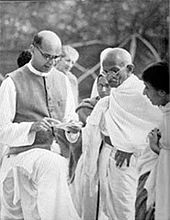 Mahadev Desai (left) reading out a letter to Gandhi from the viceroy at Birla House, Bombay, 7 April 1939
Mahadev Desai (left) reading out a letter to Gandhi from the viceroy at Birla House, Bombay, 7 April 1939
In 1932, through the campaigning of the Dalit leader B. R. Ambedkar, the government granted untouchables separate electorates under the new constitution. In protest, Gandhi embarked on a six-day fast in September 1932. The resulting public outcry successfully forced the government to adopt an equitable arrangement through negotiations mediated by Palwankar Baloo. This was the start of a new campaign by Gandhi to improve the lives of the untouchables, whom he named Harijans, the children of God.
On 8 May 1933, Gandhi began a 21-day fast of self-purification to help the Harijan movement.[44] This new campaign was not universally embraced within the Dalit community, as prominent leader B. R. Ambedkar condemned Gandhi's use of the term Harijans as saying that Dalits were socially immature, and that privileged caste Indians played a paternalistic role. Ambedkar and his allies also felt Gandhi was undermining Dalit political rights. Gandhi had also refused to support the untouchables in 1924–25 when they were campaigning for the right to pray in temples. Because of Gandhi's actions, Ambedkar described him as "devious and untrustworthy".[41] Gandhi, although born into the Vaishya caste, insisted that he was able to speak on behalf of Dalits, despite the presence of Dalit activists such as Ambedkar.
In the summer of 1934, three unsuccessful attempts were made on Gandhi's life.
When the Congress Party chose to contest elections and accept power under the Federation scheme, Gandhi resigned from party membership. He did not disagree with the party's move, but felt that if he resigned, his popularity with Indians would cease to stifle the party's membership, which actually varied, including communists, socialists, trade unionists, students, religious conservatives, and those with pro-business convictions, and that these various voices would get a chance to make themselves heard. Gandhi also wanted to avoid being a target for Raj propaganda by leading a party that had temporarily accepted political accommodation with the Raj.[45]
Gandhi returned to active politics again in 1936, with the Nehru presidency and the Lucknow session of the Congress. Although Gandhi wanted a total focus on the task of winning independence and not speculation about India's future, he did not restrain the Congress from adopting socialism as its goal. Gandhi had a clash with Subhas Bose, who had been elected president in 1938. Their main points of contention were Bose's lack of commitment to democracy[citation needed] and lack of faith in non-violence. Bose won his second term despite Gandhi's criticism, but left the Congress when the All-India leaders resigned en masse in protest of his abandonment of the principles introduced by Gandhi.[46]
World War II and Quit India
World War II broke out in 1939 when Nazi Germany invaded Poland. Initially, Gandhi favoured offering "non-violent moral support" to the British effort, but other Congressional leaders were offended by the unilateral inclusion of India in the war, without consultation of the people's representatives. All Congressmen resigned from office.[47] After long deliberations, Gandhi declared that India could not be party to a war ostensibly being fought for democratic freedom, while that freedom was denied to India itself. As the war progressed, Gandhi intensified his demand for independence, drafting a resolution calling for the British to Quit India. This was Gandhi's and the Congress Party's most definitive revolt aimed at securing the British exit from India.[48]
Gandhi was criticised by some Congress party members and other Indian political groups, both pro-British and anti-British. Some felt that not supporting Britain more in its struggle against Nazi Germany was unethical. Others felt that Gandhi's refusal for India to participate in the war was insufficient and more direct opposition should be taken, while Britain fought against Nazism yet continued to contradict itself by refusing to grant India Independence. Quit India became the most forceful movement in the history of the struggle, with mass arrests and violence on an unprecedented scale.[49] Thousands of freedom fighters were killed or injured by police gunfire, and hundreds of thousands were arrested. Gandhi and his supporters made it clear they would not support the war effort unless India were granted immediate independence. He even clarified that this time the movement would not be stopped if individual acts of violence were committed, saying that the "ordered anarchy" around him was "worse than real anarchy." He called on all Congressmen and Indians to maintain discipline via ahimsa, and Karo Ya Maro ("Do or Die") in the cause of ultimate freedom.
Gandhi and the entire Congress Working Committee were arrested in Bombay by the British on 9 August 1942. Gandhi was held for two years in the Aga Khan Palace in Pune. It was here that Gandhi suffered two terrible blows in his personal life. His 50-year old secretary Mahadev Desai died of a heart attack 6 days later and his wife Kasturba died after 18 months imprisonment on 22 February 1944; six weeks later Gandhi suffered a severe malaria attack. He was released before the end of the war on 6 May 1944 because of his failing health and necessary surgery; the Raj did not want him to die in prison and enrage the nation. He came out of detention to an altered political scene—the Muslim League for example, which a few years earlier had appeared marginal, "now occupied the centre of the political stage"[50] and the topic of Jinnah's campaign for Pakistan was a major talking point. Gandhi met Jinnah in September 1944 in Bombay but Jinnah rejected, on the grounds that it fell short of a fully independent Pakistan, his proposal of the right of Muslim provinces to opt out of substantial parts of the forthcoming political union.
Although the Quit India movement had moderate success in its objective, the ruthless suppression of the movement[clarification needed] brought order to India by the end of 1943. At the end of the war, the British gave clear indications that power would be transferred to Indian hands. At this point Gandhi called off the struggle, and around 100,000 political prisoners were released, including the Congress's leadership.
Partition of India
While the Indian National Congress and Gandhi called for the British to quit India, the Muslim League passed a resolution for them to divide and quit, in 1943.[51] Gandhi is believed to have been opposed to the partition during independence and suggested an agreement which required the Congress and Muslim League to cooperate and attain independence under a provisional government, thereafter, the question of partition could be resolved by a plebiscite in the districts with a Muslim majority.[52] When Jinnah called for Direct Action, on 16 August 1946, Gandhi was infuriated and visited the most riot prone areas to stop the massacres, personally.[53] He made strong efforts to unite the Indian Hindus, Muslims and Christians and struggled for the emancipation of the "untouchables" in Hindu society.[54]
On the 14 and 15 August 1947 the Indian Independence Act was invoked and the following carnage witnessed a displacement of up to 12.5 million people in the former British Indian Empire with an estimated loss of life varying from several hundred thousand to a million.[55] But for his teachings, the efforts of his followers, and his own presence, there would have been much more bloodshed during the partition, according to prominent Norwegian historian, Jens Arup Seip.[56]
Stanley Wolpert's words sum up Gandhi's role and views on the partition perfectly:
Their plan to carve up British India was never approved of or accepted by Gandhi, however, who realised too late that his closest comrades and disciples were more interested in power than principle, and that his own vision had long been clouded by the illusion that the struggle he led for India's freedom was a nonviolent one.
— Stanley Wolpert, Gandhi's Passion, The Life and Legacy of Mahatma Gandhi, Oxford University Press
Assassination
On 30 January 1948, Gandhi was shot while he was walking to a platform from which he was to address a prayer meeting. The assassin, Nathuram Godse, was a Hindu nationalist with links to the extremist Hindu Mahasabha, who held Gandhi responsible for weakening India by insisting upon a payment to Pakistan.[57] Godse and his co-conspirator Narayan Apte were later tried and convicted; they were executed on 15 November 1949. Gandhi's memorial (or Samādhi) at Rāj Ghāt, New Delhi, bears the epigraph "Hē Ram", (Devanagari: हे ! राम or, He Rām), which may be translated as "Oh God". These are widely believed to be Gandhi's last words after he was shot, though the veracity of this statement has been disputed.[58] Jawaharlal Nehru addressed the nation through radio:[59]
"Friends and comrades, the light has gone out of our lives, and there is darkness everywhere, and I do not quite know what to tell you or how to say it. Our beloved leader, Bapu as we called him, the father of the nation, is no more. Perhaps I am wrong to say that; nevertheless, we will not see him again, as we have seen him for these many years, we will not run to him for advice or seek solace from him, and that is a terrible blow, not only for me, but for millions and millions in this country."—Jawaharlal Nehru's address to Gandhi
Gandhi's ashes were poured into urns which were sent across India for memorial services. Most were immersed at the Sangam at Allahabad on 12 February 1948, but some were secretly taken away.[60] In 1997, Tushar Gandhi immersed the contents of one urn, found in a bank vault and reclaimed through the courts, at the Sangam at Allahabad.[60][61] Some of Gandhi's ashes were scattered at the source of the Nile River near Jinja, Uganda, and a memorial plaque marks the event. On 30 January 2008, the contents of another urn were immersed at Girgaum Chowpatty by the family after a Dubai-based businessman had sent it to a Mumbai museum.[60] Another urn has ended up in a palace of the Aga Khan in Pune[60] (where he had been imprisoned from 1942 to 1944) and another in the Self-Realization Fellowship Lake Shrine in Los Angeles.[62] The family is aware that these enshrined ashes could be misused for political purposes, but does not want to have them removed because it would entail breaking the shrines.[60]
Principles, practices and beliefs
Truth & Satyagraha
Gandhi dedicated his life to the wider purpose of discovering truth, or Satya. He tried to achieve this by learning from his own mistakes and conducting experiments on himself. He called his autobiography The Story of My Experiments with Truth.
Gandhi stated that the most important battle to fight was overcoming his own demons, fears, and insecurities. Gandhi summarised his beliefs first when he said "God is Truth". He would later change this statement to "Truth is God". Thus, Satya (Truth) in Gandhi's philosophy is "God".
Gandhi's commitment to truth has been questioned by Joseph Lelyveld, who claims that Gandhi asked journalists to quote "not the words that had actually come from his mouth but a version he authorised after his sometimes heavy editing of the transcripts".[41]
The essence of Satyagraha (lit. 'insistence/holding of truth') is that it seeks to eliminate antagonisms without harming the antagonists themselves and seeks to transform or “purify” it to a higher level. A euphemism sometimes used for Satyagraha is that it is a “silent force” or a “soul force” (a term also used by Martin Luther King Jr. during his famous “I Have a Dream” speech). It arms the individual with moral power rather than physical power. Satyagraha is also termed a “universal force,” as it essentially “makes no distinction between kinsmen and strangers, young and old, man and woman, friend and foe.”[63] Gandiji wrote: “There must be no impatience, no barbarity, no insolence, no undue pressure. If we want to cultivate a true spirit of democracy, we cannot afford to be intolerant. Intolerance betrays want of faith in one's cause.”[64] Civil disobedience and non-cooperation as practised under Satyagraha are based on the “law of suffering”,[65] a doctrine that the endurance of suffering is a means to an end. This end usually implies a moral upliftment or progress of an individual or society. Therefore, non-cooperation in Satyagraha is in fact a means to secure the cooperation of the opponent consistently with truth and justice.
Nonviolence
Although Gandhi was not the originator of the principle of non-violence, he was the first to apply it in the political field on a large scale.[66] The concept of nonviolence (ahimsa) and nonresistance has a long history in Indian religious thought and has had many revivals in Hindu, Buddhist, Jain, Jewish and Christian contexts. Gandhi explains his philosophy and way of life in his autobiography The Story of My Experiments with Truth. He was quoted as saying:
"When I despair, I remember that all through history the way of truth and love has always won. There have been tyrants and murderers and for a time they seem invincible, but in the end, they always fall — think of it, always."
"What difference does it make to the dead, the orphans, and the homeless, whether the mad destruction is wrought under the name of totalitarianism or the holy name of liberty and democracy?"
"An eye for an eye makes the whole world blind."
"There are many causes that I am prepared to die for but no causes that I am prepared to kill for."
In applying these principles, Gandhi did not balk from taking them to their most logical extremes in envisioning a world where even government, police and armies were nonviolent. The quotations below are from the book "For Pacifists."[67]
The science of war leads one to dictatorship, pure and simple. The science of non-violence alone can lead one to pure democracy...Power based on love is thousand times more effective and permanent than power derived from fear of punishment....It is a blasphemy to say non-violence can be practiced only by individuals and never by nations which are composed of individuals...The nearest approach to purest anarchy would be a democracy based on non-violence...A society organised and run on the basis of complete non-violence would be the purest anarchy.
I have conceded that even in a non-violent state a police force may be necessary...Police ranks will be composed of believers in non-violence. The people will instinctively render them every help and through mutual cooperation they will easily deal with the ever decreasing disturbances...Violent quarrels between labor and capital and strikes will be few and far between in a non-violent state because the influence of the non-violent majority will be great as to respect the principle elements in society. Similarly, there will be no room for communal disturbances....
A non-violent army acts unlike armed men, as well in times of peace as in times of disturbances. Theirs will be the duty of bringing warring communities together, carrying peace propaganda, engaging in activities that would bring and keep them in touch with every single person in their parish or division. Such an army should be ready to cope with any emergency, and in order to still the frenzy of mobs should risk their lives in numbers sufficient for that purpose. ...Satyagraha (truth-force) brigades can be organised in every village and every block of buildings in the cities. [If the non-violent society is attacked from without] there are two ways open to non-violence. To yield possession, but non-cooperate with the aggressor...prefer death to submission. The second way would be non-violent resistance by the people who have been trained in the non-violent way...The unexpected spectacle of endless rows upon rows of men and women simply dying rather than surrender to the will of an aggressor must ultimately melt him and his soldiery...A nation or group which has made non-violence its final policy cannot be subjected to slavery even by the atom bomb.... The level of non-violence in that nation, if that even happily comes to pass, will naturally have risen so high as to command universal respect.
In accordance with these views, in 1940, when invasion of the British Isles by Nazi Germany looked imminent, Gandhi offered the following advice to the British people (Non-Violence in Peace and War):[68]
"I would like you to lay down the arms you have as being useless for saving you or humanity. You will invite Herr Hitler and Signor Mussolini to take what they want of the countries you call your possessions...If these gentlemen choose to occupy your homes, you will vacate them. If they do not give you free passage out, you will allow yourselves, man, woman, and child, to be slaughtered, but you will refuse to owe allegiance to them."
In a post-war interview in 1946, he offered a view at an even further extreme:
"Hitler," Gandhi said, "killed five million Jews. It is the greatest crime of our time. But the Jews should have offered themselves to the butcher’s knife. They should have thrown themselves into the sea from cliffs... It would have aroused the world and the people of Germany... As it is they succumbed anyway in their millions."[69]
However, Gandhi realised that this level of nonviolence required incredible faith and courage, which he believed everyone did not possess. He therefore advised that everyone need not keep to nonviolence, especially if it were used as a cover for cowardice:
"Gandhi guarded against attracting to his satyagraha movement those who feared to take up arms or felt themselves incapable of resistance. 'I do believe,' he wrote, 'that where there is only a choice between cowardice and violence, I would advise violence.'"[70]
"At every meeting I repeated the warning that unless they felt that in non-violence they had come into possession of a force infinitely superior to the one they had and in the use of which they were adept, they should have nothing to do with non-violence and resume the arms they possessed before. It must never be said of the Khudai Khidmatgars that once so brave, they had become or been made cowards under Badshah Khan's influence. Their bravery consisted not in being good marksmen but in defying death and being ever ready to bare their breasts to the bullets."[71]
Gandhi also came under some political fire for his criticism of those who attempted to achieve independence through more violent means. According to a report in the Frontline magazine, he did plead several times for the commutation of the death sentence of Bhagat Singh, Rajguru and Sukhdev including a personal visit on 19 March 1931 and in a letter to the Viceroy on the day of their execution, pleading fervently for the commutation.[72]
Winston Churchill said that it was "nauseating" to see Gandhi, "a seditious Middle Temple lawyer, now posing as a fakir of a type well-known in the Middle East, striding half-naked up the steps of the Vice-regal palace. .. to parley on equal terms with the representative of the King-Emperor".[73]
He continued this argument in a number of articles reprinted in Homer Jack's The Gandhi Reader: A Sourcebook of His Life and Writings. In the first, "Zionism and Anti-Semitism," written in 1938, Gandhi commented upon the 1930s persecution of the Jews in Germany within the context of Satyagraha. He offered non-violence as a method of combating the difficulties Jews faced in Germany, stating,
If I were a Jew and were born in Germany and earned my livelihood there, I would claim Germany as my home even as the tallest Gentile German might, and challenge him to shoot me or cast me in the dungeon; I would refuse to be expelled or to submit to discriminating treatment. And for doing this I should not wait for the fellow Jews to join me in civil resistance, but would have confidence that in the end the rest were bound to follow my example. If one Jew or all the Jews were to accept the prescription here offered, he or they cannot be worse off than now. And suffering voluntarily undergone will bring them an inner strength and joy...the calculated violence of Hitler may even result in a general massacre of the Jews by way of his first answer to the declaration of such hostilities. But if the Jewish mind could be prepared for voluntary suffering, even the massacre I have imagined could be turned into a day of thanksgiving and joy that Jehovah had wrought deliverance of the race even at the hands of the tyrant. For to the God-fearing, death has no terror.[74]
Gandhi was highly criticised for these statements and responded in the article "Questions on the Jews" with "Friends have sent me two newspaper cuttings criticising my appeal to the Jews. The two critics suggest that in presenting non-violence to the Jews as a remedy against the wrong done to them, I have suggested nothing new...what I have pleaded for is renunciation of violence of the heart and consequent active exercise of the force generated by the great renunciation.[75]
Gandhi's statements regarding Jews facing the impending Holocaust have attracted criticism from a number of commentators.[76] Martin Buber wrote a sharply critical open letter to Gandhi on 24 February 1939. Buber asserted that the comparison between British treatment of Indian subjects and Nazi treatment of Jews was inappropriate; moreover, he noted that when Indians were the victims of persecution, Gandhi had, on occasion, supported the use of force.[77]
Unsurprisingly, Adolf Hitler told the British Foreign Secretary Lord Halifax in 1937 that the British should "shoot Gandhi, and if this doesn't suffice to reduce them to submission, shoot a dozen leading members of the Congress, and if that doesn't suffice shoot 200, and so on, as you make it clear that you mean business."[78]
Gandhi commented upon the 1930s persecution of the Jews in Germany within the context of Satyagraha. In the November 1938 article on the Nazi persecution of the Jews quoted above, he offered non-violence as a solution:
The German persecution of the Jews seems to have no parallel in history. The tyrants of old never went so mad as Hitler seems to have gone. And he is doing it with religious zeal. For he is propounding a new religion of exclusive and militant nationalism in the name of which any inhumanity becomes an act of humanity to be rewarded here and hereafter. The crime of an obviously mad but intrepid youth is being visited upon his whole race with unbelievable ferocity. If there ever could be a justifiable war in the name of and for humanity, a war against Germany, to prevent the wanton persecution of a whole race, would be completely justified. But I do not believe in any war. A discussion of the pros and cons of such a war is therefore outside my horizon or province. But if there can be no war against Germany, even for such a crime as is being committed against the Jews, surely there can be no alliance with Germany. How can there be alliance between a nation which claims to stand for justice and democracy and one which is the declared enemy of both?"[79][80]
Vegetarianism
As a child, Gandhi experimented with meat-eating. This was due partially to his inherent curiosity as well as his rather persuasive peer and friend Sheikh Mehtab. The idea of vegetarianism is deeply ingrained in Hindu and Jain traditions in India, and, in his native land of Gujarat, most Hindus are vegetarian and so are almost all Jains.[81][82] The Gandhi family was no exception. Before leaving for his studies in London, Gandhi made a promise to his mother, Putlibai, and his uncle, Becharji Swami, that he would abstain from eating meat, taking alcohol, and engaging in promiscuity. He held fast to his promise and gained more than a diet: he gained a basis for his life-long philosophies. As Gandhi grew into adulthood, he became a strict vegetarian. He wrote the book The Moral Basis of Vegetarianism[83] and several articles on the subject, some of which were published in the London Vegetarian Society's publication, The Vegetarian.[84] During this period, the young Gandhi became inspired by many great minds and was befriended by the chairman of the London Vegetarian Society, Dr. Josiah Oldfield.
Having also read and admired the work of Henry Stephens Salt, the young Mohandas met and often corresponded with the vegetarian campaigner. Gandhi spent much time advocating vegetarianism during and after his time in London. To Gandhi, a vegetarian diet would not only satisfy the requirements of the body, it would also serve an economic purpose as meat was, and still is, generally more expensive than grains, vegetables, and fruits. Also, many Indians of the time struggled with low income, thus vegetarianism was seen not only as a spiritual practice but also a practical one. He abstained from eating for long periods, using fasting as a form of political protest. He refused to eat until his death or his demands were met. Gandhi noted in his autobiography that vegetarianism was the beginning of his deep commitment to Brahmacharya; without total control of the palate, his success in Bramacharya would likely falter.
Gandhi also experimented with fruitarianism, stating in his autobiography, "I decided to live on a pure fruit diet, and that too composed of the cheapest fruit possible ... Raw groundnuts, bananas, dates, lemons and olive oil composed our usual diet."[85] However, late in life he broke his discipline and started taking goat's milk on the advice of his doctor. This lapse of discipline bothered him to his dying day, and he wrote, "The memory of this action even now rankles my breast and fills me with remorse, and I am constantly thinking how to give up goat's milk." He never took dairy products obtained from cows because of his view initially that milk is not the natural diet of man, disgust for cow blowing,[86] and, specifically, because of a vow to his late mother.
Nai Talim, Basic Education
Nai Talim is a spiritual principle which states that knowledge and work are not separate. Gandhi promoted an educational curriculum with the same name based on this pedagogical principle.[87]
It can be translated with the phrase 'Basic Education for all'.[88] However, the concept has several layers of meaning. It developed out of Gandhi's experience with the English educational system and with colonialism in general. In that system, he saw that Indian children would be alienated and 'career-based thinking' would become dominant. In addition, it embodied a series of negative outcomes: the disdain for manual work, the development of a new elite class, and the increasing problems of industrialisation and urbanisation.
The three pillars of Gandhi's pedagogy were its focus on the life-long character of education, its social character and its form as a holistic process. For Gandhi, education is 'the moral development of the person', a process that is by definition 'life-long'.[89]
Brahmacharya, sexuality
When Gandhi was 16 his father became very ill. Being very devoted to his parents, he attended to his father at all times during his illness. However, one night, Gandhi's uncle came to relieve Gandhi for a while. Gandhi retired to his bedroom and had sex with his wife. Shortly afterward a servant came to report that Gandhi's father had just died. Gandhi felt tremendous guilt and never could forgive himself. He came to refer to this event as "double shame." The incident had significant influence in Gandhi becoming celibate at the age of 36, while still married.[90]
This decision was deeply influenced by the philosophy of Brahmacharya — spiritual and practical purity — largely associated with celibacy and asceticism. Gandhi saw Brahmacharya as a means of becoming close with God and as a primary foundation for self-realisation. In his autobiography he tells of his battle against lustful urges and fits of jealousy with his childhood bride, Kasturba. He felt it his personal obligation to remain celibate so that he could learn to love, rather than lust. For Gandhi, Brahmacharya meant "control of the senses in thought, word and deed.".[91]
Simplicity
Gandhi earnestly believed that a person involved in public service should lead a simple life. He first displayed this principle when he gave up wearing western-style clothing, which he associated with wealth and success. When he returned to India he renounced the western lifestyle he led in South Africa, where he had enjoyed a successful legal practice.
Gandhi dressed to be accepted by the poorest person in India, advocating the use of homespun cloth (khadi). He and his followers adopted the practice of weaving their own clothes from thread they themselves spun on a charkha, and encouraged others to do so. While Indian workers were often idle due to unemployment, they had often bought their clothing from industrial manufacturers owned by British interests. The Swadeshi movement held that if Indians made their own clothes, it would deal an economic blow to the British establishment in India. Gandhian simplicity was a sign and expression of swadeshi principles. Consequently, the charkha was later incorporated into the flag of the Indian National Congress. He subsequently wore a dhoti for the rest of his life to express the simplicity of his life.
The practice of giving up unnecessary expenditure, embracing a simple lifestyle and washing his own clothes, Gandhi called "reducing himself to zero".[92] On one occasion he returned the gifts bestowed to him from the Natals for his diligent service to the community.[93]
Gandhi spent one day of each week in silence. He believed that abstaining from speaking brought him inner peace and made him a better listener. This influence was drawn from the Hindu principles of mauna (Sanskrit:मौनं — silence) and shanti (Sanskrit:शांति — peace). On such days he communicated with others by writing on paper. For three and a half years, from the age of 37, Gandhi refused to read newspapers, claiming that the tumultuous state of world affairs caused him more confusion than his own inner unrest.
After reading John Ruskin's Unto This Last, he decided to change his lifestyle and create a commune called Phoenix Settlement.
Faith
Gandhi was born a Hindu and practised Hinduism all his life. As a common Hindu, he believed all religions to be equal, and rejected all efforts to convert him to a different faith. He was an avid theologian and read extensively about all major religions. He had the following to say about Hinduism:
Hinduism as I know it entirely satisfies my soul, fills my whole being...When doubts haunt me, when disappointments stare me in the face, and when I see not one ray of light on the horizon, I turn to the Bhagavad Gita, and find a verse to comfort me; and I immediately begin to smile in the midst of overwhelming sorrow. My life has been full of tragedies and if they have not left any visible and indelible effect on me, I owe it to the teachings of the Bhagavad Gita.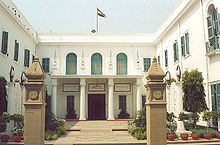 Gandhi Smriti (The house Gandhi lodged in the last 4 months of his life has now become a monument, New Delhi)
Gandhi Smriti (The house Gandhi lodged in the last 4 months of his life has now become a monument, New Delhi)
Gandhi wrote a commentary on the Bhagavad Gita in Gujarati. The Gujarati manuscript was translated into English by Mahadev Desai, who provided an additional introduction and commentary. It was published with a Foreword by Gandhi in 1946.[94][95]
Gandhi believed that at the core of every religion was truth and love (compassion, nonviolence and the Golden Rule). He also questioned what he saw as hypocrisy, malpractices, and dogma in all religions, including his own, and he was a tireless advocate for social reform in religion. Some of his comments on various religions are:
Thus if I could not accept Christianity either as a perfect, or the greatest religion, neither was I then convinced of Hinduism being such. Hindu defects were pressingly visible to me. If untouchability could be a part of Hinduism, it could but be a rotten part or an excrescence. I could not understand the raison d'être of a multitude of sects and castes. What was the meaning of saying that the Vedas were the inspired Word of God? If they were inspired, why not also the Bible and the Koran? As Christian friends were endeavouring to convert me, so were Muslim friends. Abdullah Seth had kept on inducing me to study Islam, and of course he had always something to say regarding its beauty.As soon as we lose the moral basis, we cease to be religious. There is no such thing as religion over-riding morality. Man, for instance, cannot be untruthful, cruel or incontinent and claim to have God on his side.Later in his life, when he was asked whether he was a Hindu, he replied, "Yes I am. I am also a Christian, a Muslim, a Buddhist and a Jew."
Gandhi met the Indian spiritual teacher Meher Baba aboard the S.S. Rajputana on his way to the second Round Table Conference in London in 1931, saying that he was very happy to meet Baba and asking him to break his silence.[96]
In spite of their deep reverence to each other, Gandhi and Rabindranath Tagore engaged in protracted debates more than once. These debates exemplify the philosophical differences between the two most famous Indians at the time. On 15 January 1934, an earthquake hit Bihar and caused extensive damage and loss of life. Gandhi maintained this was because of the sin committed by upper caste Hindus by not letting untouchables in their temples (Gandhi was committed to the cause of improving the fate of untouchables, referring to them as Harijans). Tagore vehemently opposed Gandhi's stance, maintaining that an earthquake can only be caused by natural forces, not moral reasons, however repugnant the practice of untouchability may be.[97]
Gandhi took a keen interest in theosophy. He empathised with theosophy's message of "universal brotherhood and consequent toleration", as he put it in 1926.[98]
Swaraj, Self-Rule
Gandhi was a self-described philosophical anarchist,[99][100] and his vision of India meant India without an underlying government.[101] He once said that "the ideally nonviolent state would be an ordered anarchy."[102] While political systems are largely hierarchical, with each layer of authority from the individual to the central government have increasing levels of authority over the layer below, Gandhi believed that society should be the exact opposite, where nothing is done without the consent of anyone, down to the individual. His idea was that true self-rule in a country means that every person rules his or herself and that there is no state which enforces laws upon the people.[103] This would be achieved over time with nonviolent conflict mediation, as power is divested from layers of hierarchical authorities, ultimately to the individual, which would come to embody the ethic of nonviolence. Rather than a system where rights are enforced by a higher authority, people are self-governed by mutual responsibilities. On returning from South Africa, when Gandhi received a letter asking for his participation in writing a world charter for human rights, he responded saying, "in my experience, it is far more important to have a charter for human duties."[104] A free India for him meant the existence of thousands of self-sufficient small communities (an idea possibly from Tolstoy) who rule themselves without hindering others. It did not mean merely transferring a British established administrative structure into Indian hands which he said was just making Hindustan into Englistan.[105] He wanted to ultimately dissolve the Congress Party after independence and establish a system of direct democracy in India,[106] having no faith in the British styled parliamentary system.[105]
Literary works
Gandhi was a prolific writer. For decades he edited several newspapers including Harijan in Gujarati, in Hindi and in the English language; Indian Opinion while in South Africa and, Young India, in English, and Navajivan, a Gujarati monthly, on his return to India. Later, Navajivan was also published in Hindi.[107] In addition, he wrote letters almost every day to individuals and newspapers. However, Andrew Roberts writes that 'we cannot be certain that he really made all the pronouncements attributed to him, since, according to Mr. Lelyveld, Gandhi insisted that journalists file "not the words that had actually come from his mouth but a version he authorised after his sometimes heavy editing of the transcripts."'.[41]
Gandhi also wrote several books including his autobiography, An Autobiography of My Experiments with Truth ((Gujarātī "સત્યના પ્રયોગો અથવા આત્મકથા")), of which he bought the entire first edition to make sure it was reprinted.[41] His other autobiographies included: Satyagraha in South Africa about his struggle there, Hind Swaraj or Indian Home Rule, a political pamphlet, and a paraphrase in Gujarati of John Ruskin's Unto This Last.[108] This last essay can be considered his programme on economics. He also wrote extensively on vegetarianism, diet and health, religion, social reforms, etc. Gandhi usually wrote in Gujarati, though he also revised the Hindi and English translations of his books.
Gandhi's complete works were published by the Indian government under the name The Collected Works of Mahatma Gandhi in the 1960s. The writings comprise about 50,000 pages published in about a hundred volumes. In 2000, a revised edition of the complete works sparked a controversy, as Gandhian followers argue that the government incorporated the changes for political purposes. The Indian government later withdrew the revised edition.[109]
Legacy and depictions in popular culture
The word Mahatma, while often mistaken for Gandhi's given name in the West, is taken from the Sanskrit words maha (meaning Great) and atma (meaning Soul). Rabindranath Tagore is said to have accorded the title to Gandhi.[110] In his autobiography, Gandhi nevertheless explains that he never valued the title, and was often pained by it.[111]
Followers and international influence
Gandhi influenced important leaders and political movements. Leaders of the civil rights movement in the United States, including Martin Luther King and James Lawson, drew from the writings of Gandhi in the development of their own theories about non-violence.[112][113][114] Anti-apartheid activist and former President of South Africa, Nelson Mandela, was inspired by Gandhi.[115] Others include Khan Abdul Ghaffar Khan,[116] Steve Biko, Aung San Suu Kyi,[117] and Benigno Aquino, Jr. (the Philippine opposition leader during the dictatorship of Ferdinand Marcos and father of current Philippine president Benigno Aquino III).
"Christ gave us the goals and Mahatma Gandhi the tactics."—Martin Luther King Jr, 1955[118]
In his early years, the former President of South Africa Nelson Mandela was a follower of the non-violent resistance philosophy of Gandhi.[115] Bhana and Vahed commented on these events as "Gandhi inspired succeeding generations of South African activists seeking to end White rule. This legacy connects him to Nelson Mandela...in a sense Mandela completed what Gandhi started."[119]
Gandhi's life and teachings inspired many who specifically referred to Gandhi as their mentor or who dedicated their lives to spreading Gandhi's ideas. In Europe, Romain Rolland was the first to discuss Gandhi in his 1924 book Mahatma Gandhi, and Brazilian anarchist and feminist Maria Lacerda de Moura wrote about Gandhi in her work on pacifism. In 1931, notable European physicist Albert Einstein exchanged written letters with Gandhi, and called him "a role model for the generations to come" in a later writing about him.[120] Lanza del Vasto went to India in 1936 intending to live with Gandhi; he later returned to Europe to spread Gandhi's philosophy and founded the Community of the Ark in 1948 (modelled after Gandhi's ashrams). Madeleine Slade (known as "Mirabehn") was the daughter of a British admiral who spent much of her adult life in India as a devotee of Gandhi.
In addition, the British musician John Lennon referred to Gandhi when discussing his views on non-violence.[121] At the Cannes Lions International Advertising Festival in 2007, former U.S. Vice-President and environmentalist Al Gore spoke of Gandhi's influence on him.[122]
President of the United States Barack Obama in an address to a Joint Session of the Parliament of India said that:
"I am mindful that I might not be standing before you today, as President of the United States, had it not been for Gandhi and the message he shared with America and the world."—Barack Obama in an address to a Joint Session of the Parliament of India, 2010[123]
Obama at the Wakefield High School speech in Sept 2009, said that his biggest inspiration came from Mahatma Gandhi. His reply was in response to the question 'Who was the one person, dead or live, that you would choose to dine with?'. He continued that "He's somebody I find a lot of inspiration in. He inspired Dr. King with his message of nonviolence. He ended up doing so much and changed the world just by the power of his ethics."
The Mahatma Gandhi District in Houston, Texas, United States, an ethnic Indian enclave, is named after Gandhi. The district officially received its named on 16 January 2010 when the City of Houston held a naming ceremony.[124]
Global holidays
On 15 June 2007, it was announced that the "United Nations General Assembly" has "unanimously adopted" a resolution declaring 2 October as "the International Day of Non-Violence."[125] 30 January of every year is observed the School Day of Non-violence and Peace in schools of many countries.[126][127] In countries with a Southern Hemisphere school calendar, it can be observed on 30 March.
Awards
Time magazine named Gandhi the Man of the Year in 1930. Gandhi was also the runner-up to Albert Einstein as "Person of the Century"[128] at the end of 1999. Einstein said of Gandhi:
Mahatma Gandhi's life achievement stands unique in political history. He has invented a completely new and humane means for the liberation war of an oppressed country, and practised it with greatest energy and devotion. The moral influence he had on the consciously thinking human being of the entire civilized world will probably be much more lasting than it seems in our time with its overestimation of brutal violent forces. Because lasting will only be the work of such statesmen who wake up and strengthen the moral power of their people through their example and educational works. We may all be happy and grateful that destiny gifted us with such an enlightened contemporary, a role model for the generations to come.
Time Magazine named The 14th Dalai Lama, Lech Wałęsa, Martin Luther King, Cesar Chavez, Aung San Suu Kyi, Benigno Aquino, Jr., Desmond Tutu, and Nelson Mandela as Children of Gandhi and his spiritual heirs to non-violence.[129] The Government of India awards the annual Gandhi Peace Prize to distinguished social workers, world leaders and citizens. Nelson Mandela, the leader of South Africa's struggle to eradicate racial discrimination and segregation, is a prominent non-Indian recipient. In 2011, Time magazine named Gandhi as one of the top 25 political icons of all time.[130]
Gandhi never received the Nobel Peace Prize, although he was nominated five times between 1937 and 1948, including the first-ever nomination by the American Friends Service Committee,[131] though he made the short list only twice, in 1937 and 1947.[132] Decades later, the Nobel Committee publicly declared its regret for the omission, and admitted to deeply divided nationalistic opinion denying the award.[54] Gandhi was nominated in 1948 but was assassinated before nominations closed. That year, the committee chose not to award the peace prize stating that "there was no suitable living candidate" and later research shows that the possibility of awarding the prize posthumously to Gandhi was discussed and that the reference to no suitable living candidate was to Gandhi.[132] When the 14th Dalai Lama was awarded the Prize in 1989, the chairman of the committee said that this was "in part a tribute to the memory of Mahatma Gandhi."[132]
Film and literature
Mahatma Gandhi has been portrayed in film, literature, and in the theatre. Ben Kingsley portrayed Gandhi in the 1982 film Gandhi, which won the Academy Award for Best Picture. Gandhi is also a central theme in the 2006 Bollywood film Lage Raho Munna Bhai. The 2007 film, Gandhi, My Father explores the relationship between Gandhi and his son Harilal. The 1996 film, The Making of the Mahatma, documents Gandhi's time in South Africa.
Several biographers have undertaken the task of describing Gandhi's life. Among them are: D. G. Tendulkar with his Mahatma. Life of Mohandas Karamchand Gandhi in eight volumes, and Pyarelal and Sushila Nayar with their Mahatma Gandhi in 10 volumes. There is also another documentary, titled Mahatma: Life of Gandhi, 1869–1948, which is 14 chapters and 6 hours long.
In April 2010, Great Soul: Mahatma Gandhi and His Struggle With India by Joseph Lelyveld was released. It contains controversial claims that Gandhi was "a sexual weirdo, a political incompetent and a fanatical faddist—one who was often downright cruel to those around him."[41] Lelyveld has stated that the press coverage "grossly distort[s]" the overall message of the book.[133] However, this did not prevent the government of the Indian state Gujarat, Gandhi's birth state, from banning the book.[134]
Current impact within India
"Gandhi remains India’s patriarch, the founding father whose face is printed on the currency, but modern India is hardly a Gandhian nation, if it ever was one. His vision of a village-dominated economy was shunted aside during his lifetime as rural romanticism, and his call for a national ethos of personal austerity and nonviolence has proved antithetical to the goals of an aspiring economic and military power ... Gandhi is still revered here, and credited with shaping India’s political identity as a tolerant, secular democracy. But he can sometimes seem to hover over modern India like a parent whose expectations are rarely met."Gandhi's birthday, 2 October, is a national holiday in India, Gandhi Jayanti. India observes 30 January the day of his assassination, as Martyr's Day, to commemorate those who gave up their lives in service of the Indian nation. There are two temples in India dedicated to Gandhi.[136] One is located at Sambalpur in Orissa and the other at Nidaghatta village near Kadur in Chikmagalur district of Karnataka. Gandhi also appears on every Indian Rupee note.
See also
- Frugal engineering
- Gandhi Memorial International Foundation
- Gandhian socialism
- Gandhian economics
- Nonviolent resistance
- Raj Ghat and associated memorials, Gandhi's cremation site
Notes
- ^ a b Gangrade, K.D., Moral Lessons From Gandhi S Autobiography And Other Essays, p. 155
- ^ Gandhi, "The Momentous Issue", Young India, 10 November 1921, in Collected Works of Mahatma Gandhi, electronic edition, vol. 25, pp. 76–8; and letter to P. Kodanda Rao, 10 September 1935, in Collected Works of Mahatma Gandhi, electronic edition, vol. 67, p. 400, where he stated: "... I found that even civil disobedience failed to convey the full meaning of the struggle. I therefore adopted the phrase civil resistance."
- ^ Bhattacharya, Sabyasachi (1997). The Mahatma and the Poet. New Delhi: National Book Trust, India. p. 1.
- ^ Gandhi means "grocer" in Gujarati (L. R. Gala, Popular Combined Dictionary, English-English-Gujarati & Gujarati-Gujarati-English, Navneet), or "perfumer" in Hindi (Bhargava's Standard Illustrated Dictionary Hindi-English).
- ^ Fischer, Louis (1954). Gandhi:His life and message for the world. Mentor.
- ^ a b c d e f g h Tendulkar, D. G. (1951). Mahatma volume 1. Delhi: Ministry of Information and Broadcasting, Government of India.
- ^ Sannuti, Arun. "Vegetarianism: The Road to Satyagraha". International Vegetarian Union (IVU). http://www.ivu.org/history/gandhi/road.html.
- ^ Pitirim Aleksandrovich Sorokin, The ways and power of love, Templeton Foundation Press 2002, p.169 ISBN 1890151866
- ^ Lloyd I. Rudolph Gandhi, the traditional roots of charisma, University of Chicago Press 1983 ISBN 0226731367
- ^ Gandhi 1940, pp. 5–7
- ^ Gandhi 1940, p. 9
- ^ Gandhi 1940, pp. 20–22
- ^ Gangrade, K.D., Moral Lessons From Gandhi S Autobiography And Other Essays, p. 154
- ^ a b c d e f Brown, Judith M (1989). Gandhi: Prisoner of Hope. New Haven: Yale University Press. p. 22. ISBN 0300051255.
- ^ Johnson, Richard L.; Gandhi, Mahatma (2006). Johnson, Richard L.. ed. Gandhi's experiments with truth: essential writings by and about Mahatma Gandhi. New York: Lexington Books. p. 150. ISBN 0739111434, 9780739111437. http://books.google.co.uk/books?id=dRQcKsx-YgQC&lpg=PP1&dq=Gandhi's%20experiments%20with%20truth%3A%20essential%20writings%20by%20and%20about%20Mahatma%20Gandhi&pg=PP1#v=onepage&q&f=false.
- ^ Gandhi, Mahatma (2009). India of my dreams. Delhi: Rajpal & Sons. p. 7,144. ISBN 9788170287407. http://books.google.co.uk/books?id=_4rl47Y-pK4C&dq=Mahatma+Gandhi+quran&source=gbs_navlinks_s.
- ^ a b Fischer, Louis (1962). Essential Gandhi. New York: Random House.
- ^ Gandhi 1940, p. 99
- ^ Gandhi 1940, p. 93
- ^ The Collected Works of Mahatma Gandhi. 8. p. 199.
- ^ The Collected Works of Mahatma Gandhi. 3. p. 255.
- ^ The Collected Works of Mahatma Gandhi. 2. p. 270.
- ^ a b Rory Carroll, "Gandhi branded racist as Johannesburg honours freedom fighter", The Guardian, 17 October 2003.
- ^ The Making of a Political Reformer: Gandhi in South Africa, 1893–1914. Surendra Bhana and Goolam Vahed, 2005: p.44
- ^ The Making of a Political Reformer: Gandhi in South Africa, 1893–1914. Surendra Bhana and Goolam Vahed, 2005: p.45
- ^ Collected Works of Mahatma Gandhi Vol 5 Document#393 from Gandhi: Behind the Mask of Divinity p106
- ^ "Sergeant Major Gandhi". Gandhism.net. http://www.gandhism.net/sergeantmajorgandhi.php. Retrieved 3 March 2009.
- ^ Collected Works of Mahatma Gandhi, Vol. 5, p. 410
- ^ Desai, Mahadev H. (1983). Autobiography: the story of my experiments with truth. Mineola, N.Y: Dover. p. 313. ISBN 0-486-24593-4. http://books.google.com/?id=OXoRs7Kxs_YC&pg=PR1.
- ^ Chronology of Mahatma Gandhi
- ^ The Story of My Experiments with Truth/Part V/Recruiting Campaign, Gandhi's Autobiography
- ^ a b "Day to Day with Gandhi by Mahadev Desai". Wikilivres.info. http://www.wikilivres.info/wiki/Day_to_Day_with_Gandhi/Volume_1/Preface. Retrieved 1 September 2010.
- ^ 67. Appeal for enlistment, Nadiad, 22 June 1918
- ^ 8. Letter to J. L. Maffey, Nadiad, 30 April 1918
- ^ Gandhi's Ideas Including Selections from His Writings Andrews, C.F. (1930) Mahatma Gandhi's Ideas (Macmillan) P.133 Chapter VII The Teaching of Ahimsa
- ^ R. Gandhi, Patel: A Life, p. 82.
- ^ R. Gandhi, Patel: A Life, p. 89.
- ^ "Gandhi Invents Spinning Wheel", December 1931, Popular Science. 1931-12. http://books.google.com/?id=ESgDAAAAMBAJ&pg=PA60&dq=Popular+Mechanics+1931+curtiss#v=onepage&q&f=true. Retrieved 29 January 2011.
- ^ Lamenting chavanni’s demise, Sudheendra Kulkarni, indian express oped, Sun 10 Jul 2011
- ^ R. Gandhi, Patel: A Life, p. 105.
- ^ a b c d e f g Among the Hagiographers, Andrew Roberts reviewing Great Soul: Mahatma Gandhi and His Struggle With India by Joseph Lelyveld
- ^ R. Gandhi, Patel: A Life, p. 131.
- ^ R. Gandhi, Patel: A Life, p. 172.
- ^ R. Gandhi, Patel: A Life, pp. 230–32.
- ^ R. Gandhi, Patel: A Life, p. 246.
- ^ R. Gandhi, Patel: A Life, pp. 277–81.
- ^ R. Gandhi, Patel: A Life, pp. 283–86.
- ^ R. Gandhi, Patel: A Life, p. 309.
- ^ R. Gandhi, Patel: A Life, p. 318.
- ^ End of Empire, p.60 Brian Lapping , Granada Publishing 1985
- ^ Keen, Shirin (Spring, 1998). "The Partition of India". Emory University. http://www.english.emory.edu/Bahri/Part.html.
- ^ Jack, Homer Alexander (1956). The Gandhi Reader: A Sourcebook of His Life and Writings By Gandhi (Mahatma). New York, NY, USA: Indiana University Press. ISBN 0-8021-3161-1.
- ^ Wolpert, Stanley. Gandhi's Passion – The Life and Legacy of Mahatma Gandhi. Oxford University Press. ISBN 0-19-513060-X. http://www.nytimes.com/books/first/w/wolpert-gandhi.html.
- ^ a b Tønnesson, Øyvind (1 December 1999). "Mahatma Gandhi, the Missing Laureate". Nobelprize.org. http://nobelprize.org/nobel_prizes/peace/articles/gandhi/.
- ^ Metcalf, Barbara; Metcalf, Thomas R (2006). A Concise History of Modern India (Cambridge Concise Histories). Cambridge and New York: Cambridge University Press. pp. 221–222. ISBN 0521682258.
- ^ Saikia, Bijoy Sankar (2 October 2006). "Why Mahatma Gandhi didn't get a Nobel Prize". CNN IBN-Live. http://ibnlive.in.com/news/why-mahatma-gandhi-didnt-get-a-nobel-prize/22985-3-single.html.
- ^ R. Gandhi, Patel: A Life, p. 472.
- ^ Vinay Lal. ‘Hey Ram’: The Politics of Gandhi’s Last Words. Humanscape 8, no. 1 (January 2001): pp. 34–38.
- ^ Nehru's address on Gandhi's death. Retrieved on 15 March 2007.
- ^ a b c d e "Gandhi's ashes to rest at sea, not in a museum" The Guardian, 16 January 2008
- ^ "GANDHI'S ASHES SCATTERED" The Cincinnati Post, 30 January 1997 "For reasons no one knows, a portion of the ashes was placed in a safe deposit box at a bank in Cuttack, 1,100 miles (1,800 km) southeast of New Delhi. Tushar Gandhi went to court to gain custody of the ashes after newspapers reported in 1995 that they were at the bank."
- ^ Ferrell, David (27 September 2001). "A Little Serenity in a City of Madness". Los Angeles Times: pp. B 2.
- ^ Gandhi, M.K. “Some Rules of Satyagraha” Young India (Navajivan) 23 February 1930 (The Collected Works of Mahatma Gandhi vol. 48, p. 340)
- ^ R. K. Prabhu & U. R. Rao, editors; from section “Power of Satyagraha,” of the book The Mind of Mahatma Gandhi[dead link], Ahemadabad, India, Revised Edition, 1967.
- ^ Gandhi, M.K. “The Law of Suffering” Young India 16 June 1920
- ^ Asirvatham, Eddy. Political Theory. S.chand. ISBN 8121903467.
- ^ Bharatan Kumarappa, Editor, "For Pacifists," by M.K. Gandhi, Navajivan Publishing House, Ahmedabad, India, 1949.
- ^ Gandhi, Mahatma (1972). Non-violence in peace and war, 1942–[1949]. Garland Publishing. ISBN 0-8240-0375-6.
- ^ Louis Fischer (1950). The life of Mahatma Gandhi. Harper. p. 348. http://books.google.com/?id=pHcGAQAAIAAJ&pg=PA348&q=%22cliffs%22.
- ^ Bondurant, p. 28.
- ^ Bondurant, p. 139.
- ^ Frontline – Of Means and Ends[dead link] by Paresh R. Vaidya.
- ^ Kevin Myers: Armistice Day poppycock threatens our free speech, Independent.ie, 28 October 2009
- ^ Jack, Homer. The Gandhi Reader, pp. 319–20.
- ^ Jack, Homer. The Gandhi Reader, p. 322.
- ^ David Lewis Schaefer. What Did Gandhi Do?. National Review, 28 April 2003. Retrieved 21 March 2006; Richard Grenier. "The Gandhi Nobody Knows"[dead link]. Commentary Magazine. March 1983. Retrieved 21 March 2006.
- ^ Hertzberg, Arthur. The Zionist Idea. PA: Jewish Publications Society, 1997, pp. 463–464.; see also Gordon, Haim. "A Rejection of Spiritual Imperialism: Reflections on Buber's Letter to Gandhi." Journal of Ecumenical Studies, 22 June 1999.
- ^ Ghose, Sankar (1992). Jawaharlal Nehru, A Biography, p.138. Allied Publishers Limited.
- ^ Jack, Homer. The Gandhi Reader, Harijan, 26 November 1938, pp. 317–318.
- ^ Mohandas K. Gandhi. A Non-Violent Look at Conflict & Violence Published in Harijan on 26 November 1938
- ^ Laidlaw, James: Riches and Renunciation. Religion, economy, and society among the Jains, Oxford 1995, pp. 166–169 ISBN 0198280319
- ^ Jain Society: Some Discrepancies Between Principles And Practice. Retrieved on 14 February 2009.
- ^ Gandhi, Mahatma (1959). The Moral Basis of Vegetarianism. Online Books Page. ISBN 0852831927. http://onlinebooks.library.upenn.edu/webbin/book/lookupid?key=olbp17620. Retrieved 2 October 2009.
- ^ "International Vegetarian Union — Mohandas K. Gandhi (1869–1948)". http://www.ivu.org/history/gandhi/.
- ^ Gokhale's Charity, My Experiments with Truth, M.K. Gandhi.
- ^ The Rowlatt Bills and my Dilemma, My Experiments with Truth, M.K. Gandhi.
- ^ Richards, Glynn (1996), A Source-Book on Modern Hinduism, Routledge, http://books.google.co.uk/books?id=BGxgNTBmFNEC&pg=PA202&dq=Nai+Talim&num=100
- ^ Basic Education (Nai Talim)
- ^ Dinabandhu Dehury: Mahatma Gandhi's Contribution to Education
- ^ "Time magazine people of the century". Time. 1 March 2000. http://www.time.com/time/time100/poc/magazine/mohandas_gandhi12b.html. Retrieved 12 March 2009.[dead link]
- ^ The Story of My Experiments with Truth — An Autobiography, p. 176.
- ^ The Story of My Experiments with Truth — An Autobiography, p. 177.
- ^ The Story of My Experiments with Truth — An Autobiography, p. 183.
- ^ Desai, Mahadev. The Gospel of Selfless Action, or, The Gita According To Gandhi. (Navajivan Publishing House: Ahmedabad: First Edition 1946). Other editions: 1948, 1951, 1956.
- ^ A shorter edition, omitting the bulk of Desai's additional commentary, has been published as: Anasaktiyoga: The Gospel of Selfless Action. Jim Rankin, editor. The author is listed as M.K. Gandhi; Mahadev Desai, translator. (Dry Bones Press, San Francisco, 1998) ISBN 1-883938-47-3.
- ^ Kalchuri, Bhau: Meher Prabhu: Lord Meher, Volume One, Manifestation, Inc., 1986, p. 1388-1392
- ^ "Overview of debates between Gandhi and Tagore". Indiatogether.org. http://www.indiatogether.org/2003/may/rvw-gndhtgore.htm. Retrieved 12 March 2009.
- ^ "What about Gandhi and theosophy?". Gandhiserve.org. 30 January 1948. http://www.gandhiserve.org/information/questions_and_answers/faq9/faq9.html. Retrieved 1 September 2010.
- ^ Snow, Edgar. The Message of Gandhi. SEP 27 March 1948. "Like Marx, Gandhi hated the state and wished to eliminate it, and he told me he considered himself 'a philosophical anarchist.'"
- ^ Articles on and by Gandhi, Retrieved on 7 June 2008.
- ^ Jesudasan, Ignatius. A Gandhian theology of liberation. Gujarat Sahitya Prakash: Ananda India, 1987, pp 236–237
- ^ From Discussion with BG Kher and others, 15 August 1940. Gandhi's Wisdom Box (1942), edited by Dewan Ram Parkash, p. 67 also in Collected works of Mahatma Gandhi Vol. 79 (PDF), p. 122
- ^ Murthy, Srinivas. Mahatma Gandhi and Leo Tolstoy Letters. Long Beach Publications: Long Beach, 1987, pp. 13, 189.
- ^ Easwaran, Eknath. Gandhi the Man. Nilgiri Press, 1998. p. 33.
- ^ a b Chapter VI Hind Swaraj by M.K. Gandhi
- ^ Bhattacharyya, Buddhadeva. Evolution of the political philosophy of Gandhi. Calcutta Book House: Calcutta, 1969, p. 479
- ^ Peerless Communicator by V.N. Narayanan. Life Positive Plus, October–December 2002
- ^ Gandhi, M. K. (in English; trans. from Gujarati) (PDF). Unto this Last: A paraphrase. Ahmedabad: Navajivan Publishing House. ISBN 81-7229-076-4. http://wikilivres.info/wiki/Unto_This_Last_%E2%80%94_M._K._Gandhi.
- ^ Collected Works of Mahatma Gandhi (CWMG) Controversy (gandhiserve)
- ^ Dutta, Krishna and Andrew Robinson, Rabindranath Tagore: An Anthology, p. 2.
- ^ Desai, Mahadev H. (1983). Autobiography: the story of my experiments with truth. Mineola, N.Y: Dover. p. viii. ISBN 0-486-24593-4. http://books.google.com/?id=OXoRs7Kxs_YC&pg=PR1.
- ^ "King’s Trip to India". Mlk-kpp01.stanford.edu. http://mlk-kpp01.stanford.edu/index.php/kingpapers/article/kings_trip_to_india/. Retrieved 1 September 2010.
- ^ By Sara Sidner CNN (17 February 2009). "King moved, as father was, on trip to Gandhi's memorial". CNN. http://www.cnn.com/2009/WORLD/asiapcf/02/17/king.anniversaryvisit/index.html. Retrieved 1 September 2010.
- ^ Placido P. D'Souza (20 January 2003). "COMMEMORATING MARTIN LUTHER KING JR.: Gandhi's influence on King". San Francisco Chronicle. http://sfgate.com/cgi-bin/article.cgi?file=/chronicle/archive/2003/01/20/ED163673.DTL. Retrieved 12 March 2009.
- ^ a b Nelson Mandela, The Sacred Warrior: The liberator of South Africa looks at the seminal work of the liberator of India, Time Magazine, 3 January 2000.
- ^ Abdul Ghaffar Khan (February 2002). "A pacifist uncovered". Findarticles.com. http://findarticles.com/p/articles/mi_m1295/is_2_66/ai_83246175/print. Retrieved 12 March 2009.
- ^ "An alternative Gandhi". The Tribune. India. 22 February 2004. http://www.tribuneindia.com/2004/20040222/spectrum/book1.htm. Retrieved 12 March 2009.
- ^ Life Magazine: Remembering Martin Luther King Jr. 40 Years Later. Time Inc, 2008. Pg 12
- ^ Surendra Bhana and Goolam Vahed, The Making of a Political Reformer: Gandhi in South Africa, 1893–1914. Chapter "Gandhi's Legacy to South Africa," 2005: p. 149
- ^ "Einstein on Gandhi". Gandhiserve.org. 18 October 1931. http://www.gandhiserve.org/streams/einstein.html. Retrieved 12 March 2009.
- ^ Lennon Lives Forever. Rolling Stone. Retrieved on 20 May 2007.
- ^ Of Gandhigiri and Green Lion, Al Gore wins hearts at Cannes. Taken from exchange4media.com. Retrieved on 23 June 2007.
- ^ "Obama's address to a Joint Session of the Parliament of India". Whitehouse.gov. 8 November 2010. http://www.whitehouse.gov/the-press-office/2010/11/08/remarks-president-joint-session-indian-parliament-new-delhi-india. Retrieved 29 January 2011.
- ^ Moreno, Jenalia. "Signs of identity." (Archive) Houston Chronicle. 16 January 2010. Retrieved on 28 January 2010.
- ^ Chaudhury, Nilova (15 June 2007). "2 October is global non-violence day". Hindustan Times (India). http://www.hindustantimes.com/storypage/storypage.aspx?id=54580f5e-15a0-4aaf-baa3-8f403b5688fa&&Headline=October+2+is+Int'l+Non-Violence+Day. Retrieved 15 June 2007.
- ^ DENIP, School Day of Non-violence and Peace. Denip.webcindario.com (31 January 1983). Retrieved on 4 June 2011.
- ^ School Day of Non-violence and Peace. Cartadelapaz.org (30 January 2009). Retrieved on 4 June 2011.
- ^ Rushdie, Salman (13 April 1998). "The Time 100". Time Magazine Online. http://www.time.com/time/time100/leaders/profile/gandhi.html. Retrieved 3 March 2009.
- ^ The Children Of Gandhi. Time. Retrieved on 21 April 2007.
- ^ "Top 25 Political Icons". Time Magazine Online. 4 February 2011. http://www.time.com/time/specials/packages/article/0,28804,2046285_2045996_2045906,00.html. Retrieved 9 February 2011.
- ^ AFSC's Past Nobel Nominations.
- ^ a b c Tønnesson, Øyvind (1 December 1999). "Mahatma Gandhi, the Missing Laureate". nobelprize.org. http://nobelprize.org/nobel_prizes/peace/articles/gandhi/index.html.
- ^ US author slams Gandhi gay claim. The Australian (29 March 2011). Retrieved on 4 June 2011.
- ^ Indian state bans Gandhi book. Adelaide Now (30 March 2011). Retrieved on 4 June 2011.
- ^ Obama Invokes Gandhi, Whose Ideal Eludes India by Jim Yardley, The New York Times, November 6, 2010
- ^ "Here, Gandhi is god". Bangaloremirror.com. 2 October 2010. http://www.bangaloremirror.com/article/10/201010022010100204445248420e2db29/Here-Gandhi-is-god.html. Retrieved 29 January 2011.
References
- Gandhi, R (2007). Gandhi: the man, his people, and the empire. University of California Press, 2008. ISBN 0520255704, 9780520255708.
Further reading
- Bhana, Surendra and Goolam Vahed. The Making of a Political Reformer: Gandhi in South Africa, 1893–1914. New Delhi: Manohar, 2005.
- Bondurant, Joan V. Conquest of Violence: The Gandhian Philosophy of Conflict. Princeton UP, 1988 ISBN 0-691-02281-X
- Chernus, Ira. American Nonviolence: The History of an Idea, chapter 7. ISBN 1-57075-547-7
- Chadha, Yogesh. Gandhi: A Life. ISBN 0-471-35062-1
- Dalton, Dennis (ed). Mahatma Gandhi: Selected Political Writings. Indianapolis/Cambridge: Hackett Publishing Company, 1996. ISBN 0-87220-330-1
- Easwaran, Eknath. Gandhi the Man. ISBN 978-1586380557 ebook: ISBN 978-1586380670
- Fischer, Louis. The Essential Gandhi: An Anthology of His Writings on His Life, Work, and Ideas. Vintage: New York, 2002. (reprint edition) ISBN 1-4000-3050-1
- Fischer, Louis. The Life of Mahatma Gandhi. Harper & Row, New York, 1950. ISBB 0-06-091038-0 (1983 pbk.)
- Gandhi, M.K. Satyagraha in South Africa
- Gandhi, M.K. The Gandhi Reader: A Sourcebook of His Life and Writings. Homer Jack (ed.) Grove Press, New York, 1956.
- Gandhi, M.K. (1940). An Autobiography or The Story of My Experiments With Truth. Ahmedabad: Navajivan Publishing House. 2nd edition. pp. xii, 404. (also available at wikisource). ISBN 0-8070-5909-9.
- Gandhi, Mahatma. The Collected Works of Mahatma Gandhi. New Delhi: Publications Division, Ministry of Information and Broadcasting, Govt. of India, 1994.
- Gandhi, Rajmohan. Patel: A Life. Navajivan Publishing House, 1990 ISBN 81-7229-138-8
- Gordon, Haim. A Rejection of Spiritual Imperialism: Reflections on Buber's Letter to Gandhi. Journal of Ecumenical Studies, 22 June 1999.
- Hunt, James D. Gandhi in London. New Delhi: Promilla & Co., Publishers, 1978.
- Mann, Bernhard, The Pedagogical and Political Concepts of Mahatma Gandhi and Paulo Freire. In: Claußen, B. (Ed.) International Studies in Political Socialization and Education. Bd. 8. Hamburg 1996. ISBN 3-926952-97-0
- Rühe, Peter. Gandhi: A Photo biography. ISBN 0-7148-9279-3
- Sharp, Gene. Gandhi as a Political Strategist, with Essays on Ethics and Politics. Boston: Extending Horizon Books, 1979.
- Singh, Col. G. B. Gandhi Behind the Mask of Divinity. Prometheus Books, 2004. ISBN 978-1573929981
- Singh, Col. G. B. and Watson, Dr. Tim Gandhi Under Cross Examination, Sovereign Star Publishing, 2008. ISBN 0981499201
- Sofri, Gianni. Gandhi and India: A Century in Focus. (1995) ISBN 1-900624-12-5
External links
- Mahatma Gandhi's autobiography
- Works by Mahatma Gandhi at Project Gutenberg
- Gandhi's biography from Stanford's King Encyclopedia
- Gandhi Smriti — Government of India website
- Mahatma Gandhi News Research and Media service
- Mani Bhavan Gandhi Sangrahalaya Gandhi Museum & Library
- Gandhi Book Centre
- Works by Mahatma Gandhi
- Works by or about Mohandas Karamchand Gandhi in libraries (WorldCat catalog)
- When Gandhi was an honoured guest in Sri Lanka
- Mahatma Gandhi, the Missing Laureate from the Nobel Prize official website
- The Biography Channel: Mahatma Gandhi — Pilgrim Of Peace at Google Videos (Adobe Flash video)
- All Men are Brothers, book of selected quotations and excerpts from Gandhi's writings, compiled by Krishna Kripalani (given away by the copyright holder, UNESCO)
Mohandas Karamchand Gandhi Family Influences Life Civil rights movement in South Africa · Bardoli Satyagraha · Champaran and Kheda Satyagraha · Non-cooperation · Chauri Chaura · Purna Swaraj · Salt Satyagraha · Vaikom Satyagraha · Poona Pact · Quit India · AssassinationPhilosophy Associates Vinoba Bhave · Vallabhbhai Patel · Mirabehn · C. F. Andrews · Narhari Parikh · Ravi Shankar Vyas · Mohanlal Pandya · Mahadev Desai · Abbas Tyabji · Khan Abdul Ghaffar Khan · Dada Dharmadhikari · J. C. Kumarappa · Hermann KallenbachLegacy Influenced Martin Luther King, Jr. · James Lawson · James Bevel · Nelson Mandela · Steve Biko · Aung San Suu Kyi · Maria Lacerda de Moura · Lanza del VastoMemorials at Kanyakumari · Martin Luther King, Jr., National Historic Site · Pietermaritzburg · Rajghat · National Gandhi Museum · Gandhi SmritiMemorial observances  Category
CategoryIndian National Congress 
Presidents Bonnerjee · Naoroji · Tyabji · Yule · Wedderburn · Mehta · Charlappa · Bonnerjee · Dadabhai Naoroji · Webb · Banerjea · Sayani · Nair · A. M. Bose · Dutt · Chandavarkar · Wacha · Banerjea · L. Ghosh · H. Cotton · Gokhale · Naoroji · R. Ghosh · (1907-1908) Malaviya · Wedderburn · Dar · Mudholkar · Bahadur · B. N. Bose · Sinha · Mazumdar · Besant · Malaviya · Imam · M. Nehru · Rai · C. Vijayaraghavachariar · Khan · Das · M. Ali · A. K. Azad · M. Gandhi · Naidu · Iyengar · Ansari · M. Nehru · J. Nehru · S. V. Patel · Malaviya (1932-1933) · Nellie Sengupta · Rajendra Prasad (1934-1935) · J. Nehru (1936-1937) · S. C. Bose · (1938-1939) · A. K. Azad (1940-1946) · Kripalani · Sitaramayya (1948-1949) · Tandon · J. Nehru (1951-1954) · Dhebar (1955-1959) · I. Gandhi · Reddy (1960-1963) · K. Kamaraj (1964-1967) · S. Nijalingappa (1968-1969) · J. Ram (1970-1971) · D. Sharma (1972-1974) · Baruah (1975-1977) · I. Gandhi (1978-1984) · R. Gandhi (1985-1991) · Narasimha Rao (1992-1996) · Kesri (1996-1998) · S. Gandhi
(1998-present)Frontal Organizations Internal Organizations Congress President · Working President · Congress Working Committee · Central Election Committee · All India Congress Committee · Pradesh Congress CommitteePradesh committees Andhra Pradesh PCC · Assam PCC · Bihar PCC · Chhatisgarh PCC · Delhi PCC · Gujarat PCC · Haryana PCC · Himachal Pradesh PCC · Jammu & Kashmir PCC · Jharkhand PCC · Karnataka PCC · Kerala PCC · Maharashtra PCC · Madhya Pradesh PCC · Meghalaya PCC · Mizoram PCC · Mumbai PCC · Nagaland PCC · Orissa PCC · Puducherry PCC · Punjab PCC · Rajasthan PCC · Tamil Nadu PCC · Tripura PCC · Uttarakhand PCC · Uttar Pradesh PCC · West Bengal PCCHistory Business and Economics: Arts, Literature and Culture: Akira Kurosawa (Japan)Science and Technology: Moral and Spiritual Leadership: Mohandas K. Gandhi (India)
AsianWeek · CNN · TIME Asia Indian independence movement History Colonisation · East India Company · British India · French India · Portuguese India · Plassey · Buxar · Anglo-Mysore Wars · Anglo-Maratha Wars (First · Second · Third) · Polygar War · Vellore Mutiny · First Anglo-Sikh War · Second Anglo-Sikh War · Rebellion of 1857 · British Raj · more





Philosophies
and ideologiesIndian nationalism · Swaraj · Hindu nationalism · Gandhism · Satyagraha · Indian Muslim nationalism · Swadeshi · Socialism · Khilafat MovementEvents and
movementsPartition of Bengal · Revolutionaries · Delhi-Lahore Conspiracy · The Indian Sociologist · The Sedetious conspiracy · Champaran and Kheda · Rowlatt Committee · Rowlatt Bills · Jallianwala Bagh Massacre · Non-Cooperation · Qissa Khwani Bazaar massacre · Flag Satyagraha · Bardoli · 1928 Protests · Nehru Report · Purna Swaraj · Salt Satyagraha · Round table conferences · Act of 1935 · Legion Freies Indien · Cripps' mission · Quit India · Indian National Army · Tiger Legion · Bombay Mutiny · Coup d'État de Yanaon · Provisional Government of IndiaOrganisations Indian National Congress · All-India Muslim League · Anushilan Samiti · Jugantar · Arya Samaj · Rashtriya Swayamsevak Sangh · India House · Berlin Committee · Ghadar · Home Rule · Khaksar Tehrik · Khudai Khidmatgar · Hindustan Republican Association · Swaraj Party · Indian Independence League · All India Kisan Sabha · Azad Hind · moreSocial
reformersMohandas Karamchand Gandhi · Rahul Sankrityayan · Mahatma Jyotirao Phule · Gopal Ganesh Agarkar · Shahu Maharaj · Dr. Babasaheb Ambedkar · Dhondo Keshav Karve · Vitthal Ramji Shinde · Mahadev Govind Ranade · Swami Dayananda Saraswati · Ramakrishna · Swami Vivekananda · Swami Sahajanand Saraswati · Vakkom Moulavi · Vinoba Bhave · Baba Amte · Ram Mohan Roy · Gopal Hari DeshmukhIndian
independence
activistsPuli Thevar · Yashwantrao Holkar · Rahul Sankrityayan · Swami Sahajanand Saraswati · Tipu Sultan · Veerapandiya Kattabomman · Sangolli Rayanna · Baba Ram Singh · Mangal Pandey · Rae Ahmed Nawaz Khan Kharal · Bakht Khan · Veer Kunwar Singh · Rani of Jhansi · Bahadur Shah Zafar · Swami Dayanand Saraswati · Bal Gangadhar Tilak · Gopal Krishna Gokhale · Dadabhai Naoroji · Bhikaiji Cama · Shyamji Krishna Varma · Annie Besant · Har Dayal · Subramanya Bharathi · Lala Lajpat Rai · Bipin Chandra Pal · Rash Behari Bose · Chittaranjan Das · Bidhan Chandra Roy · Khan Abdul Ghaffar Khan · Maulana Azad · Ashfaqullah Khan · Ram Prasad Bismil · Chandrasekhar Azad · Rajaji · K. M. Munshi · Bhagat Singh · Sarojini Naidu · Achyut Patwardhan · Purushottam Das Tandon · Alluri Sitaramaraju · M. Ali Jinnah · Sardar Patel · Vakkom Majeed · Subhash Chandra Bose · Jawaharlal Nehru · Mohandas Karamchand Gandhi · Allama Mashriqi · Accamma Cherian · Swadeshabhimani Ramakrishna Pillai · Kotwal Dhan Singh Gurjar · V. K. Krishna Menon · A. J. John, Anaparambil · more
British leaders Independence Simla Conference · Cabinet Mission · Indian Independence Act · Partition of India · Political integration · Constitution · Republic of IndiaHindu reform movements Ayyavazhi · Arya Samaj · Divine Life Society · Hindutva · ISKCON · Ramakrishna Mission · Sri Aurobindo Ashram · Swadhyay Parivar · Topics Reformers Sri Aurobindo · Sita Ram Goel · M.S. Golwalkar · Mahatma Gandhi · Harsh Narain · The Mother · Prabhupada · Raja Ram Mohun Roy · Pandurang Shastri Athavale · Ramakrishna · Dayananda Saraswati · Satsvarupa dasa Goswami · V.D. Savarkar · Swami Sivananda · Arun Shourie · Ram Swarup · B.G. Tilak · Swami Vivekananda · Yogananda · Swami Vipulananda · Arumuga Navalar · moreSocial and political philosophy Philosophers Adi Shankara · Plato · Vaisheshika · Nyāya Sūtras · Augustine · Marsilius · Machiavelli · Grotius · Montesquieu · Comte · Bosanquet · Spencer · Malebranche · Durkheim · Santayana · Royce · Russell · Confucius · Hobbes · Leibniz · Hume · Kant · Rousseau · Locke · Burke · Smith · Bentham · Mill · Thoreau · Marx · Gandhi · Gentile · Maritain · Berlin · Schmitt · Debord · Camus · Sartre · Foucault · Rawls · Popper · Đilas · Habermas · Kirk · Oakeshott · Nozick · Alinsky · Chomsky · Baudrillard · Badiou · Strauss · Rand · Žižek · Walzer
Social theories Social concepts Society · War · Law · Justice · Peace · Rights · Revolution · Civil disobedience · Democracy · Social contract · more...
Related articles Philosophy of economics · Philosophy of education · Philosophy of history · Jurisprudence · Philosophy of social science · Philosophy of love · Philosophy of sex
Categories:- Mohandas Karamchand Gandhi
- 20th-century philosophers
- Alumni of University College London
- Anarcho-pacifists
- Anti-poverty advocates
- Ascetics
- Assassinated Indian politicians
- Attempted assassination survivors
- Deaths by firearm in India
- Expatriates in South Africa
- Founders of Indian schools and colleges
- Gandhians
- Gujarati literature
- Gujarati people
- Gujarati writers
- Hindu pacifists
- Indian anarchists
- Indian anti-war activists
- Indian autobiographers
- Indian civil rights activists
- Indian expatriates in the United Kingdom
- Indian Hindus
- Indian humanitarians
- Indian independence activists
- Indian memoirists
- Indian murder victims
- Indian pacifists
- Indian philosophers
- Indian politicians
- Indian socialists
- Indian tax resisters
- Indian vegetarians
- International opponents of apartheid in South Africa
- Murdered anarchists
- Natal Indian Congress politicians
- Nonviolence advocates
- People murdered in India
- People of British India
- People of the Second Boer War
- Presidents of the Indian National Congress
- Recipients of the Kaisar-i-Hind Medal
- South African Indian Congress politicians
- Tolstoyans
- 1869 births
- 1948 deaths
- People from Porbandar
- Indian emigrants to South Africa
- Prisoners and detainees of British India
- Relief workers in Noakhali
- Mohandas Karamchand Gandhi family
Wikimedia Foundation. 2010.

